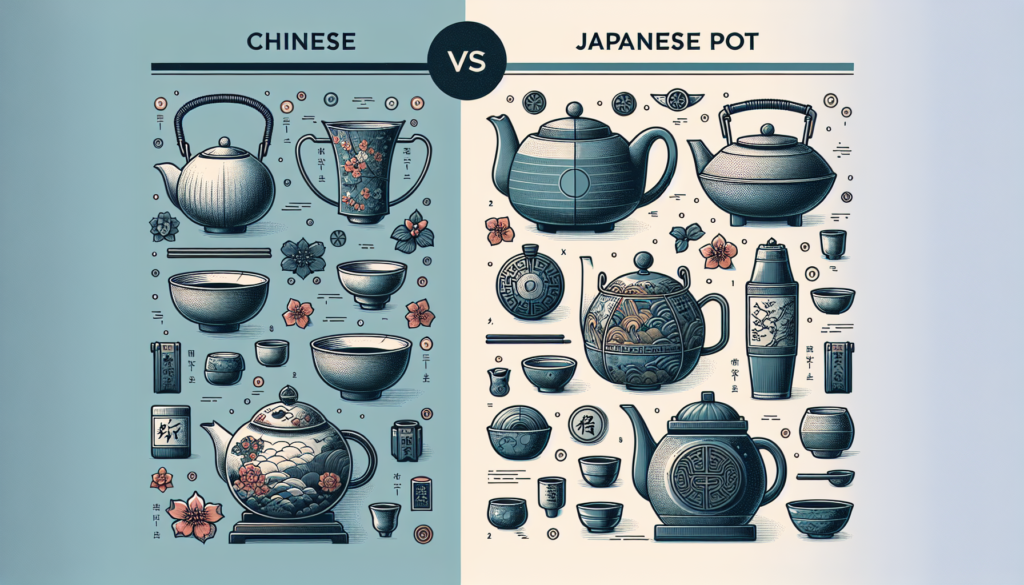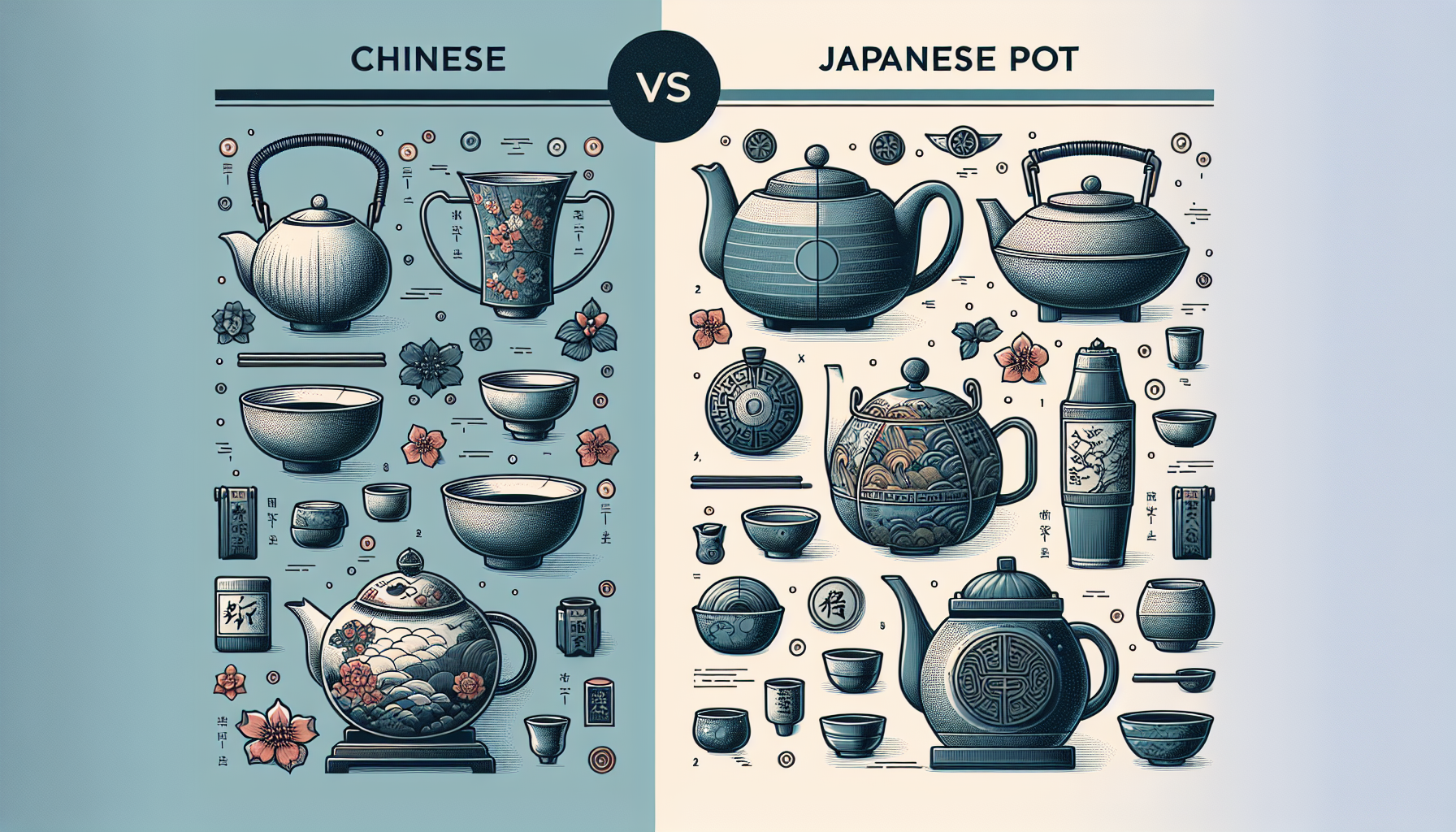Get ready to explore the world of tea pots as we uncover the fascinating differences between Chinese and Japanese designs. From the intricate craftsmanship to the distinct cultural influences, these tea pots showcase the rich traditions and artistry of both countries. Discover how Chinese tea pots embody elegance and wisdom, while Japanese tea pots captivate with simplicity and harmony. Whether you’re a tea enthusiast or simply curious about the cultural nuances, this article will reveal the unique characteristics that make each tea pot style truly captivating. So grab a cup of tea and let’s embark on this delightful journey of discovery together.

CHECK OUT TEA KETTLES AND TEAPOTS ON AMAZON
Shape and Design
Chinese Tea Pots
Chinese tea pots are known for their elegant and artistic designs. They often feature a rounded shape, with a small spout and a handle. The lid of a Chinese tea pot is usually quite tight-fitting, ensuring that the tea does not spill while being poured. Chinese tea pots can come in a variety of sizes, from small individual pots to larger ones for serving multiple cups.
Japanese Tea Pots
Japanese tea pots, on the other hand, often have a more simplistic and minimalist design. They typically feature a straight and tall shape, with a handle that is perpendicular to the spout. Japanese tea pots are known for their practicality, with a wide opening to easily add and remove tea leaves. The lids of Japanese tea pots are usually loose and can be easily removed.
Materials Used
Chinese Tea Pots
Chinese tea pots are traditionally made from clay, specifically Yixing clay. This clay is known for its porous nature, allowing the tea pots to absorb the flavors of the tea over time. The clay used in Chinese tea pots is often left unglazed, allowing the natural earthy tones of the clay to shine through. Some Chinese tea pots may also be made from porcelain or glass.
Japanese Tea Pots
Japanese tea pots are commonly made from porcelain, which is known for its durability and ability to retain heat. Porcelain tea pots are typically glazed, giving them a smooth and shiny finish. Some traditional Japanese tea pots may also be made from cast iron, which provides excellent heat retention properties.
Decoration and Artistry
Chinese Tea Pots
Chinese tea pots are renowned for their intricate and detailed decoration. They are often adorned with hand-painted designs, calligraphy, or even carved patterns. These decorations can range from traditional motifs, such as dragons or bamboo, to scenes from nature or cultural symbols. Each Chinese tea pot is a work of art in its own right, with skilled artisans showcasing their talent through these elaborate designs.
Japanese Tea Pots
Japanese tea pots, on the other hand, embrace a more minimalist approach to decoration. They often feature simple and understated designs, with a focus on clean lines and subtle colors. The beauty of Japanese tea pots lies in their simplicity and elegance, allowing the natural materials and craftsmanship to take center stage. Some Japanese tea pots may have a single hand-painted motif or a small amount of gold or silver accents.
Functionality
Chinese Tea Pots
Chinese tea pots are designed with functionality in mind. The shape and size of the pot are carefully chosen to ensure optimal brewing conditions for different types of tea. The small spout of a Chinese tea pot allows for precise pouring, preventing any tea leaves from escaping into the cup. The tight-fitting lid ensures that the tea stays hot while brewing and can be easily removed when pouring.
Japanese Tea Pots
Japanese tea pots prioritize functionality as well. The tall and narrow shape of the pot is designed to retain heat, allowing the tea to stay hot for a longer period of time. The wide opening makes it easy to add and remove tea leaves, while the handle provides a comfortable grip for pouring. The loose lid of a Japanese tea pot allows for easy cleaning and maintenance.
Cultural Significance
Chinese Tea Pots
In Chinese culture, tea is not simply a beverage, but rather an integral part of daily life. Chinese tea pots hold a deep cultural significance and are considered to be a representation of harmony and balance. They are often passed down through generations, with each pot carrying the memories and traditions of the family. Chinese tea pots are also frequently used in traditional tea ceremonies and are highly valued as a symbol of hospitality and respect.
Japanese Tea Pots
Japanese tea pots hold a similar cultural significance, playing a central role in the Japanese tea ceremony known as “chanoyu”. This traditional ceremony is a highly ritualized and meditative practice, where the preparation and serving of tea are seen as a form of art. Japanese tea pots are considered to be a vessel for the spirit of the tea, embodying the principles of tranquility, purity, and respect. They are often adorned with symbolic motifs and patterns, further emphasizing their cultural importance.
Historical Background
Chinese Tea Pots
The history of Chinese tea pots dates back centuries, with the art of pottery and tea drinking deeply rooted in Chinese culture. The earliest Chinese tea pots were likely made from pottery, but it was during the Ming Dynasty (1368-1644) that Yixing clay tea pots gained popularity. Yixing clay is unique to the Yixing region of China and is prized for its natural mineral composition, which enhances the flavor of the tea. Chinese tea pots have since evolved in style and design, reflecting the different dynasties and artistic influences throughout history.
Japanese Tea Pots
Japanese tea pots have a rich history as well, with tea drinking introduced to Japan from China in the 9th century. Initially, tea was enjoyed by a select few, including the aristocracy and Buddhist monks. However, it wasn’t until the 16th century under the influence of tea master Sen no Rikyu that the tea ceremony became more accessible to the general public. Japanese tea pots began to be produced in larger quantities to meet the growing demand, and the art of tea pottery flourished during the Edo period (1603-1868).
Tea Culture and Ceremony
Chinese Tea Pots
Chinese tea culture is deeply ingrained in the traditions and daily life of the Chinese people. Tea is seen as a way to relax, connect with nature, and nurture the mind and body. Chinese tea pots are used in various ceremonies, such as Gongfu tea, where the tea is brewed in small amounts and served in multiple infusions. The ceremony involves precise movements and attention to detail, emphasizing the elegance and grace of tea preparation.
Japanese Tea Pots
In Japan, the tea ceremony is a highly revered art form that holds a spiritual significance. Japanese tea pots are used in the traditional tea ceremony known as “chanoyu”, where every movement is carefully choreographed and imbued with symbolism. The tea ceremony is seen as a way to achieve inner peace and harmony, allowing participants to escape the stresses of daily life and find tranquility in the present moment.
Durability and Heat Retention
Chinese Tea Pots
Chinese tea pots made from Yixing clay are known for their durability and excellent heat retention properties. The porous nature of the clay allows the tea pot to absorb the flavors and aromas of the tea, enhancing the taste over time. Yixing clay tea pots also have the ability to gradually release heat, keeping the tea warm for extended periods without excessive heat loss.
Japanese Tea Pots
Japanese tea pots made from porcelain or cast iron are also highly durable and have excellent heat retention properties. Porcelain tea pots are known for their ability to retain heat, ensuring that the tea stays hot for longer. Cast iron tea pots are particularly renowned for their superior heat retention, as the iron evenly distributes heat throughout the pot. This allows the tea to steep slowly, resulting in a rich and flavorful brew.
CHECK OUT TEA KETTLES AND TEAPOTS ON AMAZON
Cost and Availability
Chinese Tea Pots
Chinese tea pots, especially those made from Yixing clay, can vary greatly in cost depending on the quality, rarity, and craftsmanship. Authentic Yixing tea pots can be quite expensive, as they are handmade by skilled artisans using traditional techniques. However, there are also more affordable options available for those looking to start their collection. Chinese tea pots can be found in specialty tea shops, antique stores, and online marketplaces.
Japanese Tea Pots
Japanese tea pots, whether made from porcelain or cast iron, are generally more widely available and affordable compared to their Chinese counterparts. Porcelain tea pots are commonly found in tea shops and department stores, while cast iron tea pots can be sourced from specialty retailers. The cost of Japanese tea pots can vary depending on factors such as the design, size, and brand, but there are plenty of options available for different budgets.
Preference and Usage
Chinese Tea Pots
The preference for Chinese tea pots often depends on personal taste and the type of tea being brewed. Chinese tea pots, particularly those made from Yixing clay, are especially favored for brewing delicate teas such as green tea, oolong tea, and pu-erh tea. The clay is said to improve the flavor and aroma of these teas over time. Chinese tea pots are also well-suited for Gongfu tea brewing, where the focus is on multiple infusions and extracting the full flavor of the tea leaves.
Japanese Tea Pots
Japanese tea pots are highly regarded for their simplicity and functionality. They are commonly used for brewing a variety of Japanese green teas, including matcha, sencha, and genmaicha. The clean lines and smooth surfaces of Japanese tea pots make them easy to clean and maintain. Japanese tea pots are also favored for their ability to retain heat, ensuring a consistent and enjoyable brewing experience.
In conclusion, while both Chinese and Japanese tea pots serve the same purpose of brewing and serving tea, they differ in their shape, design, materials used, decoration, and cultural significance. Chinese tea pots are known for their elegant and intricate designs, typically made from Yixing clay, while Japanese tea pots embody simplicity and functionality, often made from porcelain or cast iron. The choice between Chinese and Japanese tea pots ultimately depends on personal preference, the type of tea being brewed, and the appreciation for the cultural and artistic aspects of tea pottery.

